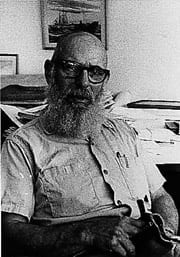Dean F. Bumpus
The Woods Hole Oceanographic Institution announces with great sorrow the death March 14, 2002, of retiree Dean F. Bumpus at his home in Woods Hole. He was 89.
Dean Franklin Bumpus was born May 11, 1912, in Newburyport, MA, and attended Melrose High School and Wilbraham Academy. He received a bachelor’s degree in biology from Oberlin College in 1933, did graduate work at Brown University in physiology and chemistry from 1935 to 1937, and attended Harvard College from 1938 to 1939. While at Brown he also worked as a laboratory instructor.
Dean Bumpus, affectionately called Bump, joined the staff at Woods Hole Oceanographic Institution in June 1937 as a biological technician working with George Clarke. He was promoted to senior observer in 1942, Associate in Oceanography in 1945, and to Oceanographer in 1950. In 1963 he was promoted to Senior Scientist, and was named Scientist Emeritus in April 1978. He also served as Sea Grant Coordinator from 1974 to 1977.
One of the first year-round employees at the Institution, Dean Bumpus helped conduct what many consider the first comprehensive survey of the marine life of Georges Bank, and with George Clarke developed the Clark-Bumpus plankton sampler. Data he collected during the 19939-1941 Research Vessel Atlantis surveys of Georges Bank provided a three-dimensional data set for plankton, larval fish and hydrography over two winter/spring periods and is still of great value more than 60 years later to biologists working on Georges Bank as part of the Global Ocean Ecosystem Dynamics (GLOBEC ) program.
During World War II Bump and Allyn Vine, Bill Schevill and others worked closely with the U.S. submarine fleet to instruct submariners on how to use the bathythermograph, an instrument designed by Institution staff, to avoid acoustic detection from enemy surface vessels by using the temperature and density gradients of the near-surface water column. The group was commended by the U.S. Navy for the many lives they helped to save. During and shortly after the war he also worked with the Office of Scientific Research and Development on submarine warfare, heading the Oceanographic Support office for Radiological Safety Reconnaissance as part of Operations Crossroads in 1946.
Much of Bump’s career at WHOI was spent tracking surface and bottom currents in the western North Atlantic, using information from surface drift bottles with return to sender notes and seabed drifters shaped like yellow mushrooms. Although he couldn’t say how many surface drifters were deployed during the program, during the 1960s alone 165,566 bottles were released by ships and planes along the U.S. East Coast, with an estimated ten percent return. In September 1959, Bump issued the following memo: “All hands are respectfully requested (until further notice) to bring their dead soldiers to the lab and deposit them in the box just inside the gate. Whiskey, rum, beer, wine or champagne bottles will be used to make drift bottles. Any clean bottles — 8 oz to one quart in size will be gratefully received. Bottoms Up!”
During the 1960s Bump also deployed some 75,485 seabed drifters, receiving an estimated 19% return. Although very simple devices, both the surface and seabed drifters contributed significant information on the surface and bottom circulation along the continental shelf of eastern North America, sometimes to the dismay of others with much more sophisticated technology. Bump sometimes attracted media attention and some interesting volunteers to his efforts. A drifter that Vice President Hubert Humphrey dropped from WHOI’s Research Vessel Atlantis II in July 1967 in the vicinity of Jeffrey’s Ledge off Gloucester was found four years later by a local fisherman, just twenty miles away. Drift bottles are still returned from time to time to the WHOI Data Library.
Long-time colleague and friend Bruce Warren remembers Bump as a generous, good-natured, hearty and exuberant man whose characteristic “haw haw haw” laugh rolled down the halls. Other colleagues remember his enthusiasm, love of the ocean and going to sea, and skills as a sailor. Local newspaper columnist Hugh McCartney chronicled some of Bump’s activities and personality in a Falmouth Enterprise column in April 1999 entitled “WHOI Hall of Famer,” referring to him as “one of the real WHOI giants of the early days.”
Much of Bump’s personal time was devoted to children. He formed Cub Scout and Boy Scout troops in the Falmouth area, and spent 40 years training leaders on the national level, earning awards for his skills and contributions to scouting.
After he retired from WHOI in 1977 he lived in Denmark and Brownfield, Maine, noting that he intended to go far enough inland that when visitors saw the great oar mounted on the front of the barn they would ask him what kind of flail that might be. His last years were spent at the family home in Woods Hole, visiting with friends and colleagues.
He is survived by his companion, Marcia Wells of Woods Hole; a son, Peter Bumpus of Woods Hole; two grandchildren, Matthew Bumpus of Woods Hole and Heidi Kelley of Bourne, MA; and four great-grandchildren. His wife, Katherine Sylvia (Miner) Bumpus, died in 1991.
A memorial service will be held in June in Woods Hole.

